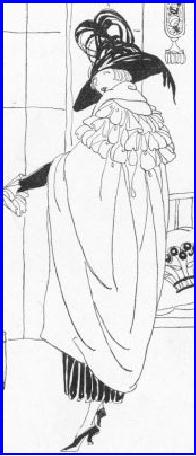 |
THE ARTIST AND HIS COSTUME |
| << MARK TWAIN'S LOVE OF COLOUR IN ALL COSTUMING |
| IDIOSYNCRASIES IN COSTUME >> |

Mark
Twain concluded an analysis of
modern religion with "--why
the God I
believe in
is too busy spinning spheres
to have time to listen to
human prayers."
How
often his words have
been in our mind since war
has shaken our
planet.
CHAPTER
XXIV
THE
ARTIST AND HIS COSTUME
HE
world
has the habit of deriding
that which it does not
understand. It
is
the most primitive way of
bolstering one's limitations.
How often the
woman
or man with a God-given
sense of the beautiful, the
fitting,
harmony
between costume and setting, is
described as poseur or poseuse
by
those who lack the same
instinct. In a sense, of course,
everything man does,
beyond
obeying the rudimentary
instincts of the savage, is an
affectation, and it is
not
possible to claim that even
our contemporary costuming of
man or woman
always
has raison
d'être.
We
accept as the natural,
unaffected raiment for woman
and man that which
custom
has taught us to recognise as
appropriate, with or without
reason for being.
For
example, the tall, shiny,
inflexible silk hat of man,
and the tortuous high
French
heels
of woman are in themselves
neither beautiful, fitting,
nor made to meet the
special
demands of any setting or
circumstance. Both hat and heels
are fashions,
unbeautiful
and uncomfortable, but to the eye of
man to-day serve as insignia
of
formal
dress, decreed by
society.
The
artist nature has always
assumed poetic license in
the matter of dress, and as
a
rule
defied custom, to follow an
inborn feeling for beauty.
That much-maligned
short
velvet coat and soft loose
tie of the painter or
writer, happen to have a
most
decided
raison
d'être; they
represent comfort, convenience, and in
the case of the
velvet
coat, satisfy a sensitiveness to texture,
incomprehensible to other natures.
As
for
the long hair of some
artists, it can be a pose, but it
has in many cases
been
absorption
in work, or poverty--the actual
lack of money for the
conventional
haircut.
In cities we consider long
hair on a man as effeminate, an
indication of
physical
weakness, but the Russian
peasant, most sturdy of
individuals, wears his
hair
long, and so do many others
among extremely primitive
masculine types, who
live
their lives beyond the reach
of Fashion and barbers.
The
short hair of the sincere
woman artist is to save time
at the toilette.
There
is always a limited number of
men and women who, in
ordinary acts of
life,
respond
to texture, colour or line, as
others do to music or scenery, and to be
at
their
best in life, must dress
their parts as they feel
them. Japanese actors who
play
the
parts of women, dress like
women off the stage, and
live the lives of women
as
nearly
as possible, in order to acquire the
feeling for women's
garments; they train
their
bodies to the proper
feminine carriage, counting upon
this to perfect their
interpretations.
The
woman who rides, hunts, shoots,
fishes, sails her own boat,
paddles, golfs and
plays
tennis, is very apt to look
more at home in habit, tweeds and
flannels, than
she
does in strictly feminine
attire; the muscles she
has acquired in legs and
arms,
from
violent exercise, give an actual,
not an assumed, stride and a
swing to the
upper
body. In sports clothes, or severely
tailored costume, this woman
is at her
best.
Most trying for her will be
demi-toilette (house gowns).
She is beautiful at
night
because a certain balance, dignity and
grace are lent her by
the décolletage
and
train of a dinner or ball
gown. English women who
are devotees of
sport,
demonstrate
the above fact over and over
again.
While
on the subject of responsiveness to
texture and colour we would
remind the
reader
that Richard Wagner hung
the room in which he worked
at his operas with
bright
silks, for the art
stimulus he got from colour,
and it is a well-known fact
that
he
derived great pleasure from wearing
dressing gowns and other garments
made
from
rich materials.
Clyde
Fitch, our American
playwright, when in his
home, often wore velvet
or
brocaded
silks. They were more
sympathetic to his artist
nature, more in accord
with
his fondness for wearing
jewelled studs, buttons,
scarf-pins. In his town
and
country
houses the main scheme,
leading features and every
smallest detail were
the
result of Clyde Fitch's
personal taste and effort, and
he, more than most
men
and
women, appreciated what a
blot an inartistic human
being can be on a
room
which
of itself is a work of
art.
PLATE
XXX
Souvenirs
of an artist designer's
unique
establishment,
in spirit and accomplishment
vrai
Parisienne. Notice
the long cape in
the
style
of 1825.
Tappé
himself will tell you that
all periods
have
had their beautiful lines and
colours;
their
interesting details; that to
find beauty
one
must first have the
feeling for it; that
if
one
is not born with this
subtle instinct,
there
are
manifold opportunities for
cultivating it.
His
claim is the same as that
made in our Art
of
Interior Decoration; the
connoisseur is one
who
has passed through the
schooling to be
acquired
only by contact with
masterpieces,
--those
treasures sifted by
time and
preserved
for our education, in great
art
collections.
Tappé
emphasises the necessity of
knowing
the
background for a costume
before planning
it;
the value of line in the
physique beneath
the
materials; the interest to be
woven into a
woman's
costume when her
type is
recognised,
and the modern insistence
on

appropriateness--that
is, the simple
gown
and
close hat for the car,
vivid colours for
field
sports or beach; a large fan for
the
woman
who is mistress of sweeping
lines,
etc.,
etc.
Tappé
is absolutely French in his
insistence
upon
the possible eloquence of line; a
single
flower
well poised and the chic
which is
dependent
upon how
a hat or gown is put on.
We
have heard him say: "No, I
will not claim
the
hat in that photograph,
though I made it,
because
it is mal
posé."
Sketched
for "Woman as
Decoration"
by Thelma
Cudlipp
Tappé's
Creations
In
England, and far more so in
America, men are put
down as effeminate who
wear
jewelry
to any marked extent. But no
less a person than King
Edward VII always
wore
a chain bangle on his arm,
and one might cite countless
men of the Continent
as
thoroughly masculine--Spaniards in
particular--who wear as many
jewelled
rings
as women. Apropos of this, a
famous topaz, worn as a ring
for years by a
distinguished
Spaniard was recently inherited by a
relation in America--a
woman.
The
stone was of such importance as a gem,
that a record was kept of
its passing
from
France into America. As a man's ring it
was impressive and the setting
such as
to
do it honour, but being a man's
ring, it was too heavy for a
woman's use. A
Table of Contents:
- A FEW HINTS FOR THE NOVICE WHO WOULD PLAN HER COSTUMES
- THE LAWS UNDERLYING ALL COSTUMING OF WOMAN
- HOW TO DRESS YOUR TYPE
- THE PSYCHOLOGY OF CLOTHES
- ESTABLISH HABITS OF CARRIAGE WHICH CREATE GOOD LINE
- COLOUR IN WOMAN'S COSTUME
- FOOTWEAR
- JEWELRY AS DECORATION
- WOMAN DECORATIVE IN HER BOUDOIR
- WOMAN DECORATIVE IN HER SUN-ROOM
- I. WOMAN DECORATIVE IN HER GARDEN:WOMAN DECORATIVE ON THE LAWN
- WOMAN AS DECORATION WHEN SKATING
- WOMAN DECORATIVE IN HER MOTOR CAR
- HOW TO GO ABOUT PLANNING A PERIOD COSTUME
- I. THE STORY OF PERIOD COSTUMES:II. EGYPT AND ASSYRIA
- DEVELOPMENT OF GOTHIC COSTUME
- THE RENAISSANCE
- EIGHTEENTH CENTURY
- WOMAN IN THE VICTORIAN PERIOD
- SEX IN COSTUMING
- LINE AND COLOUR OF COSTUMES IN HUNGARY
- STUDYING LINE AND COLOUR IN RUSSIA
- MARK TWAIN'S LOVE OF COLOUR IN ALL COSTUMING
- THE ARTIST AND HIS COSTUME
- IDIOSYNCRASIES IN COSTUME
- NATIONALITY IN COSTUME
- MODELS
- WOMAN COSTUMED FOR HER WAR JOB
- IN CONCLUSION